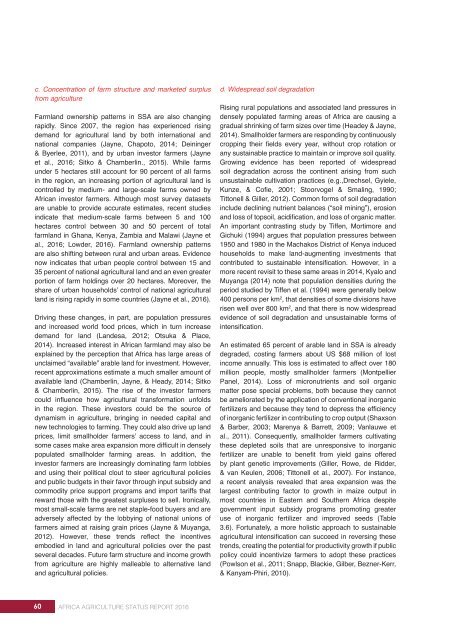AFRICA AGRICULTURE STATUS REPORT 2016
AASR-report_2016-1
AASR-report_2016-1
Create successful ePaper yourself
Turn your PDF publications into a flip-book with our unique Google optimized e-Paper software.
c. Concentration of farm structure and marketed surplus<br />
from agriculture<br />
Farmland ownership patterns in SSA are also changing<br />
rapidly. Since 2007, the region has experienced rising<br />
demand for agricultural land by both international and<br />
national companies (Jayne, Chapoto, 2014; Deininger<br />
& Byerlee, 2011), and by urban investor farmers (Jayne<br />
et al., <strong>2016</strong>; Sitko & Chamberlin., 2015). While farms<br />
under 5 hectares still account for 90 percent of all farms<br />
in the region, an increasing portion of agricultural land is<br />
controlled by medium- and large-scale farms owned by<br />
African investor farmers. Although most survey datasets<br />
are unable to provide accurate estimates, recent studies<br />
indicate that medium-scale farms between 5 and 100<br />
hectares control between 30 and 50 percent of total<br />
farmland in Ghana, Kenya, Zambia and Malawi (Jayne et<br />
al., <strong>2016</strong>; Lowder, <strong>2016</strong>). Farmland ownership patterns<br />
are also shifting between rural and urban areas. Evidence<br />
now indicates that urban people control between 15 and<br />
35 percent of national agricultural land and an even greater<br />
portion of farm holdings over 20 hectares. Moreover, the<br />
share of urban households’ control of national agricultural<br />
land is rising rapidly in some countries (Jayne et al., <strong>2016</strong>).<br />
Driving these changes, in part, are population pressures<br />
and increased world food prices, which in turn increase<br />
demand for land (Landesa, 2012; Otsuka & Place,<br />
2014). Increased interest in African farmland may also be<br />
explained by the perception that Africa has large areas of<br />
unclaimed “available” arable land for investment. However,<br />
recent approximations estimate a much smaller amount of<br />
available land (Chamberlin, Jayne, & Heady, 2014; Sitko<br />
& Chamberlin, 2015). The rise of the investor farmers<br />
could influence how agricultural transformation unfolds<br />
in the region. These investors could be the source of<br />
dynamism in agriculture, bringing in needed capital and<br />
new technologies to farming. They could also drive up land<br />
prices, limit smallholder farmers’ access to land, and in<br />
some cases make area expansion more difficult in densely<br />
populated smallholder farming areas. In addition, the<br />
investor farmers are increasingly dominating farm lobbies<br />
and using their political clout to steer agricultural policies<br />
and public budgets in their favor through input subsidy and<br />
commodity price support programs and import tariffs that<br />
reward those with the greatest surpluses to sell. Ironically,<br />
most small-scale farms are net staple-food buyers and are<br />
adversely affected by the lobbying of national unions of<br />
farmers aimed at raising grain prices (Jayne & Muyanga,<br />
2012). However, these trends reflect the incentives<br />
embodied in land and agricultural policies over the past<br />
several decades. Future farm structure and income growth<br />
from agriculture are highly malleable to alternative land<br />
and agricultural policies.<br />
d. Widespread soil degradation<br />
Rising rural populations and associated land pressures in<br />
densely populated farming areas of Africa are causing a<br />
gradual shrinking of farm sizes over time (Headey & Jayne,<br />
2014). Smallholder farmers are responding by continuously<br />
cropping their fields every year, without crop rotation or<br />
any sustainable practice to maintain or improve soil quality.<br />
Growing evidence has been reported of widespread<br />
soil degradation across the continent arising from such<br />
unsustainable cultivation practices (e.g.,Drechsel, Gyiele,<br />
Kunze, & Cofie, 2001; Stoorvogel & Smaling, 1990;<br />
Tittonell & Giller, 2012). Common forms of soil degradation<br />
include declining nutrient balances (“soil mining”), erosion<br />
and loss of topsoil, acidification, and loss of organic matter.<br />
An important contrasting study by Tiffen, Mortimore and<br />
Gichuki (1994) argues that population pressures between<br />
1950 and 1980 in the Machakos District of Kenya induced<br />
households to make land-augmenting investments that<br />
contributed to sustainable intensification. However, in a<br />
more recent revisit to these same areas in 2014, Kyalo and<br />
Muyanga (2014) note that population densities during the<br />
period studied by Tiffen et al. (1994) were generally below<br />
400 persons per km 2 , that densities of some divisions have<br />
risen well over 800 km 2 , and that there is now widespread<br />
evidence of soil degradation and unsustainable forms of<br />
intensification.<br />
An estimated 65 percent of arable land in SSA is already<br />
degraded, costing farmers about US $68 million of lost<br />
income annually. This loss is estimated to affect over 180<br />
million people, mostly smallholder farmers (Montpellier<br />
Panel, 2014). Loss of micronutrients and soil organic<br />
matter pose special problems, both because they cannot<br />
be ameliorated by the application of conventional inorganic<br />
fertilizers and because they tend to depress the efficiency<br />
of inorganic fertilizer in contributing to crop output (Shaxson<br />
& Barber, 2003; Marenya & Barrett, 2009; Vanlauwe et<br />
al., 2011). Consequently, smallholder farmers cultivating<br />
these depleted soils that are unresponsive to inorganic<br />
fertilizer are unable to benefit from yield gains offered<br />
by plant genetic improvements (Giller, Rowe, de Ridder,<br />
& van Keulen, 2006; Tittonell et al., 2007). For instance,<br />
a recent analysis revealed that area expansion was the<br />
largest contributing factor to growth in maize output in<br />
most countries in Eastern and Southern Africa despite<br />
government input subsidy programs promoting greater<br />
use of inorganic fertilizer and improved seeds (Table<br />
3.6). Fortunately, a more holistic approach to sustainable<br />
agricultural intensification can succeed in reversing these<br />
trends, creating the potential for productivity growth if public<br />
policy could incentivize farmers to adopt these practices<br />
(Powlson et al., 2011; Snapp, Blackie, Gilber, Bezner-Kerr,<br />
& Kanyam-Phiri, 2010).<br />
60 <strong>AFRICA</strong> <strong>AGRICULTURE</strong> <strong>STATUS</strong> <strong>REPORT</strong> <strong>2016</strong>


